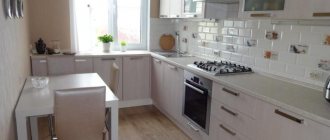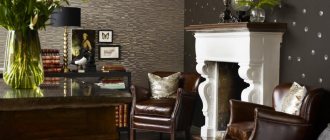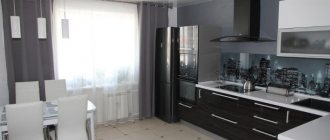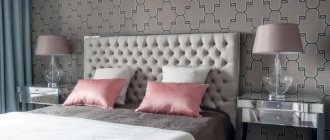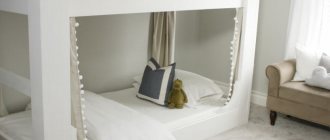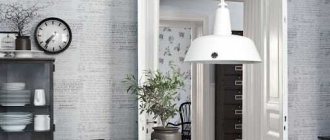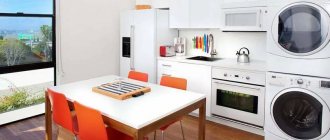The combination of different materials and textures is actively used in the decoration of modern kitchen spaces. One of the most interesting and complex techniques is combining several types of wallpaper within one room.
Wallpaper can have different textures, colors or patterns. Often in the kitchen interior two types are combined, which differ not only in color, but also in material. For example, for the dining area they choose bright, colored ones, printed from paper or non-woven fabric, and for the work area - plain, dark, washable or vinyl.
Among the latest new products of the year, special attention is drawn to the elegant combination of three light walls and one contrasting one, covered with wallpaper with trendy stripes or other fashionable patterns.
The technique of combining finishes in the kitchen helps to highlight the dining space, designate a resting place, visually zoning the kitchen.
The advantages of this approach are obvious:
- visual expansion of space;
- allocation of a dining area;
- getting into modern trends;
- achieving external aesthetics.
Using the technique of combining finishing options, you can turn even the smallest kitchen in a Khrushchev-era building into a stylish and modern one, which is clearly shown in the photo below.
In order for the design to look organic, it is necessary to keep in mind that not only colors and colors must be combined, but also texture, texture and finishing material.
For example, a combination of light-colored paper wallpaper with glossy vinyl wallpaper of a dark shade will most likely be unsuccessful.
The chosen combination should have something in common: color scheme, material, texture. The most advantageous look is wallpaper made from the same material, but in different tones, shades, colors and prints. As a last resort, it is permissible to use finishing from another material to decorate a small area of the wall - for example, as a backdrop in a workplace.
The use of finishing with a completely different texture must be justified - for example, if an accent wall is used, when its entire area is highlighted with the help of bright, patterned, embossed or printed wallpaper. Often, a work area is allocated in this way.
The accentuation of the dining area also looks stylish in the photo.
Also, a completely different texture can be used to decorate the ceiling of doorways or arches.
You can take a risk and try a combination of not two, but three types of texture and color finish. For example, for work area, accent wall, main walls and flow. But such a technique requires an impeccable sense of taste and style.
When planning a kitchen renovation, pay attention to modern ideas about fashionable combinations of wallpaper of different colors and shades. As a bonus, you will receive a fashionable, modern and functional interior.
Accent wall
It is designed to attract attention, that is, it is better to make it bright and unusual. These can be coatings with large flowers, photo wallpapers, geometric designs, etc. It is important not to overdo it with paints, otherwise the interior will be oversaturated and lose its uniqueness.
For it, choose bright wallpaper or wallpaper with a pattern. The remaining walls serve as a background, so it is better to choose plain wallpaper for them.
In the interior of a small kitchen
A small kitchen is present in many apartments, especially older ones, the layout of which makes it impossible to expand it. Housewives usually get used to cooking in such a limited area, but a large kitchen is still their dream. Designers know how to at least visually enlarge a room, including with the help of photo wallpaper.
You can visually increase the area
They must be light shades. The basic rule: the smaller the kitchen itself, the smaller the print on the photo wallpaper should be. Massive images will look ridiculous: an enlarged large fruit, especially in dark colors. Small flowers would be a good option; if these are products, then they should be small, small in size.
Also, to decorate a small kitchen, it is important to choose suitable wallpaper for the remaining walls. The simplest design solution for enlarging a room is to use stripes, both vertical and horizontal. The former will make the kitchen visually higher, and the latter - wider.
Stripes are a great option for combination
Tip Using stripes for small rooms does not mean that there will be nothing else on the roll except them. Many of the designs contain the same flowers, geometric shapes, and patterns with stripes.
Photo wallpaper covering the entire wall is not suitable for a small kitchen; it is better to limit yourself to small fragments. You can use them for the area between the work surface (table, stove) and hanging kitchen cabinets or the ceiling. If you apply them to the entire wall, it will look ridiculous, and in a small room there is unlikely to be an entire free wall.
It is better to focus on only one wall
Vertical combination
It is optimal for narrow and long rooms. It also allows you to make ceilings visually higher.
When coming up with a design for combined wallpaper for the kitchen, pay attention to the photos below. On them you will see one of the most common finishing methods - vertical combination.
Vertical stripes. You can create a unique play of light and color by covering the walls alternately with stripes of different wallpaper. You can combine both contrasting colors and shades of the same color, creating a gradation.
You can choose wallpaper of the same shade, but with different textures - for example, alternate matte and glossy.
An interesting option: alternating wallpaper with a pattern and plain ones. The resulting stripes imitate real paintings. This technique is appropriate in a spacious kitchen.
The photo shows a harmonious combination in the English style - at the bottom, vertical stripes create an imitation of wall panels, at the top is a classic floral pattern. The joint between the two types of wallpaper is decorated with a decorative border.
The most commonly used wallpaper is striped. They can be located:
- Symmetrical. In this case, the walls are covered with wide stripes mirrored from the center. Contrasting colors attract the eye, so few people pay attention to the disproportion of the room configuration.
- Asymmetrical. Only one wall is covered with canvases with wide stripes, while canvases with a similar pattern, but of different widths, are applied to other surfaces. This makes the room look wider.
Correctly selected colors will also help to place accents in the room. Too bright shades should be alternated with pastels 1-1 or 1-2. It all depends on the size of the room and the desired effect.
Fashion is back
Over time, such ideas have become truly outdated. Why is this kitchen design becoming relevant again today?
Very popular material
Modern photo wallpapers differ in many ways from the “Sovdepov” ones:
- Quality. High computer resolution allows you to create an image that is as close as possible to a photograph, so the result is not an artificial picture, but a photo that “comes to life” as much as possible. No dots are visible, all colors are bright, their range allows you to display the entire variety of existing shades.
- Dimensions. On the Soviet market, all wallpapers were the same size, because apartments did not differ in particular variety. Today, the image can be ordered in any format, depending on where you want to place it - on a free wall, above the kitchen surface, on any other area.
- Exclusive. You choose the subject that will be captured on the roll yourself. This could be a finished picture found on the Internet, or it could be a photo from a personal archive. In the latter case, you can be sure that this will not happen in any other kitchen.
The pattern can be chosen individually to suit your kitchen
Advice Some people choose personal photos for kitchen photo wallpaper, where they are depicted with their favorite food or the product itself separately. Watermelon lovers can capture the taste of their favorite fruit, while others will want to use a photo from a vacation in another country with an exotic fruit.
Horizontal companion wallpaper
Used in rooms with high ceilings, it fits perfectly into any interior design. Designers use this move to transform an overly tall room.
The photo shows a combined wallpaper with horizontal stripes and a floral pattern.
You can combine wallpapers of different textures and shades horizontally. Choose options that are in harmony with each other and with the overall design of the kitchen.
To calculate the height of each strip, visually divide the wall into three horizontal parts. The narrowest strip should be located at the bottom.
One of the most popular solutions is to use wooden or cork panels in the lower part. The top can be covered with coverings with geometric patterns, large flowers, or simply bright plain fabrics.
If the lower part stands out with a bright and large ornament, then it is better to choose a plain top.
Striped wallpaper, separated from the top part by a border or molding, can also be used as panels. At the top it is better to use canvases with small patterns or single-color ones.
You can vary either colors or texture. It’s worth choosing an option that will complement the overall design of your room, presenting it in the most favorable light.
Ceiling
Finishing the ceiling in the kitchen can be done in many ways: plasterboard and suspended ceilings, foam boards, plastic panels, painting. Wallpapering the kitchen is the easiest, low-budget and fastest option. Even if for some reason the appearance of the wallpaper deteriorates, gluing new ones will not be difficult, unlike dismantling the same drywall. It is better to choose smooth wallpaper that will not accumulate dust and grease, and a coating of light shades will help to visually “raise” the ceiling. This finishing is simple and can be done independently.
Patchwork
Patchwork is an original combination technique that is appropriate in country, Provence or ethno style. Wallpaper with different patterns is cut into equal pieces and pasted over the wall, alternating blocks.
There should be no more than 3-4 designs and number of color solutions. It is also not uncommon to see a ready-made pattern on wallpaper in the patchwork style.
The photo shows bright wallpaper in the patchwork style. They give the interior coziness and a feeling of home warmth.
In the process of choosing source materials, you should be guided by the compatibility of colors, compliance with a given style and common sense. In this way you can decorate a fragment of a surface or one wall from floor to ceiling. It all depends on the courage of your idea.
This option is worth a closer look for those who gravitate towards a variety of textures and color shades, but cannot find a suitable solution for themselves.
The work ahead is quite complex, since initially it is necessary to select the optimal combinations, and only then create an effective picture from disparate pieces.
Patchwork attracts creative individuals who dream of transforming their home and are able to carry out such painstaking work on their own.
Tile laying methods
The method of laying the tiles depends primarily on their size, the presence or absence of decorative elements and the design that must be implemented. There are three standard installation methods:
- traditional - tiles, regardless of their size, are laid in even rows, its seams form an even grid;
- laying with an offset or “staggered” pattern resembles brickwork, when the tiles of the next row are laid so that its middle is above the seam of the previous row;
- diagonally - the main direction of laying from one corner of the plane to the other. For this method it is better to use square tiles.
Options for laying tiles
The listed laying methods can be used for both walls and floors, but when using one or another method on different planes, there are specific features. It is better when the walls and floor are tiled with tiles from the same collection, then the different planes visually become a single whole. If an unconventional method of laying tiles is chosen, then an additional 15 percent must be added to the required amount of material, which will be spent on trimming and creating the desired pattern.
Photo wallpaper and 3D
Photo wallpapers immediately become bright accents. Therefore, for the remaining walls it is better to choose plain wallpaper in soft colors.
3D images have also become one of the popular varieties of our time, creating the effect of presence and volume.
A beautiful cityscape creates an accent and gives a sense of volume to the room.
The choice of options is incredibly wide, ranging from classic food and drink themes (fruits, coffee and coffee beans, chocolate) to three-dimensional abstraction.
Such a picture should be as open as possible for viewing, so it is best to apply it to the most open surface possible. In most cases, the only one is the wall in the area of the dining table.
They can be created on any basis: non-woven, synthetic fabrics, vinyl. High-quality paints make them bright and resistant to fading even in direct sunlight.
They are also environmentally friendly, fire-resistant, wear-resistant, and easy to maintain. To wash them, you can use any household chemicals. But still, the most significant and impressive advantage is its incredible aesthetics. In addition, absolutely any image can be transferred to the canvas.
Small floral pattern
Floral ornaments and fantasy patterns are a steady trend in recent years in fashion in general and in kitchen design in particular. A small floral pattern in pastel colors is something that will fit perfectly into the decor of a small kitchen in a Khrushchev-era building. The drawing should be small and fractional.
Small kitchen decorated with wallpaper in a warm sand tone
Tip: When evaluating wallpaper, expand it a few meters. A wide picture from a distance may look very different than from an arm's length away.
Floral ornaments and fantasy patterns are a steady trend in recent years in fashion in general and in kitchen design in particular.
See also: How to choose the right photo wallpaper for a nursery
Combination with other types of finishes
A combination of wallpaper and other finishing materials looks much more interesting: tiles, bricks, concrete, painting, wood panels, cork, decorative plaster, mosaics.
There are hundreds of options, but there are a few general rules.
- 1 Same thickness. The thickness of the coatings should be approximately the same, which will eliminate problems with joining.
- 2 Do not use expensive and budget analogues at the same time. Give preference to materials from the same price category that differ in texture and color.
- 3 Same shine. For example, matte tiles look bad against the backdrop of shiny, glossy wallpaper. It is desirable that the degree of gloss be as identical as possible.
- 4 In combination with any wallpaper, even the most expensive, another finishing material still becomes accentuated. Therefore, it is better to rely on neutral colors for wallpaper.
- 5 Adhere to zoning principles. Chaotic inserts of other finishing materials around the perimeter of the entire kitchen will bring disharmony. Complement large prints with wallpapers with small patterns or plain colors, and rich colors with pastels.
You will find more original ideas for using combined wallpaper for the kitchen in the interior in the photos provided.
Everyone can find individual solutions for themselves, striking in sophistication and exclusivity.
The right color combination
You need to select colors in accordance with the overall design of the kitchen. The wall covering should become a background that improves the mood and creates comfort. It is not recommended to use many colors on wallpaper at once. A harmonious design is obtained by combining 2-3 colors.
- Cool colors - gray, blue, blue, green - combine well with each other.
- Warm colors are yellow, red, orange, they allow you to make the kitchen lighter.
- Neutral colors are gray, beige, white, black. Combine with any shades, patterns and prints on wallpaper.
Which color scheme should I choose?
If you select wallpaper for the kitchen, then you can use bright, “tasty” colors, but do not forget that they should be in harmony with the furniture. Wallpaper in the kitchen should also be washable.
Wallpaper for the living room should be selected in accordance with everyone's preferences, because... This is the place where the whole family spends most of their time.
Wallpaper in the bedroom should have muted tones, calm, because... this is a vacation spot.
For a child’s room, you should choose wallpaper that is not too colorful, not dark, and try to avoid aggressive shades, otherwise the color will have an impact on the child’s immature psyche and will affect his behavior.
Wallpaper selection
When choosing wall decor in the kitchen, you will certainly have to face difficult problems. Today, design technologies allow you to choose different types of wallpaper to bring your wildest ideas to life.
What kind of wallpaper should I put in the kitchen? Let's look at the types of paperwork:
- Vinyl. This is a two-layer coating, the base is non-woven fabric and paper, the top coating is vinyl spraying. The advantage of this type of wallpaper is its moisture resistance. This allows them to be washed even with detergents. When applying vinyl wallpaper, glue is applied to the wall itself where the coating is glued. A special glue is used that resists the formation of fungus and mold.
- Natural. Bamboo can be used as a material for natural wallpaper. This option is environmentally friendly and safe for health. The disadvantage of such a coating is that it is impossible to paste it near the cooking area, since the wallpaper can quickly become covered with soot, deteriorate, or even peel off. However, they can be gently wiped with a damp sponge.
- Paintable wallpaper. This type of non-woven wallpaper is very practical and convenient. They are produced colorless with a slight relief, which allows you to choose any shade of the walls.
Fashionable solutions
Let's consider unusual pasting solutions:
- Textile. This is a type of vinyl wallpaper designed to look like textile fabric (polka dot prints, checkered patterns, or floral designs can be used).
- Wallpaper 3D. Unusual prints, designs and play of tones can be used here.
- Silkscreen printing. This is one type of practical vinyl flooring that can be washed. This wallpaper is made using the hot stamping method.
- Ethnic style. They can be stylized to look like plaster, leather, silk interspersed with gold threads, etc.
- Watercolor patterns. This is wallpaper with delicate, slightly blurry patterns that smoothly flow into each other.
- Pastel shades. This coating, as a rule, is without ornaments and prints. The shades are pleasant and calm: mint, ocher, soft pink, light beige.
